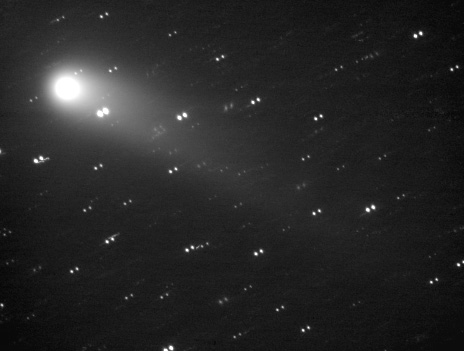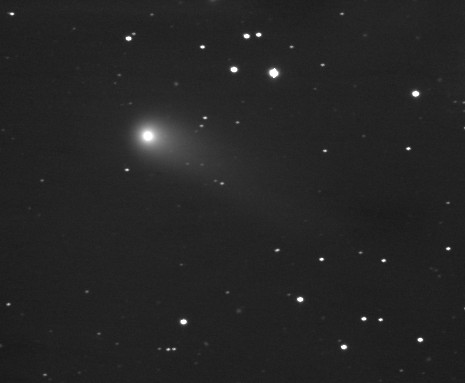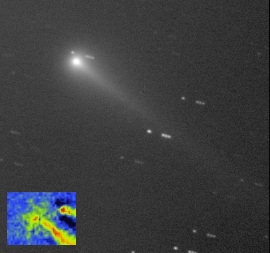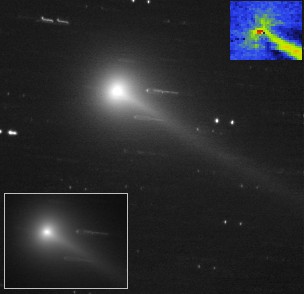Comets C/2004 Q2 (Machholz ) and C/2004 R2 (ASAS).


Here are some CCD images of these interesting comets, grabbed by Gianluca Masi and Franco Mallia, as part of an educational project
To get them, we used the SoTIE telescope in Las Campanas and we are very grateful to the NASA/TIE team (in particular Roger Wilcox for operating the scope while we observe), as well as to Software Bisque, for their support and disposability. We also thank Carnegie Observatories and Las Campanas Observatory for hosting the SoTIE telescope in Chile. Images are in inverse chronological order.
When noted, images have been captured using the 0.5m-f/3 Campocatino Austral Observatory (CAO), located in S. Pedro de Atacama - Chile - and hosted at the SPACE facility, by Alain Maury, Gianluca Masi and Franco Mallia.
This page will be updated once new images will be available, check it regularly!. Those wishing to use them, are kindly asked to contact us. Last update: 15 Nov. 2004.
This page is mirrored at the Campocatino Astronomical Observatory website
Choose your comet:
C/2004 Q2 (Machholz) - C/2004 R2 (ASAS)
Comet C/2004 Q2 was discovered by
Don Machholz on 27 Aug. 2004. First orbit computation suggested it could be an interesting object for the incoming winter. And, indeed, is giving a nice show!. Those wishing to locate it, can use this map (a position is given every 5 days), coming from TheSkySix
BREAKING NEWS (15 dec. 2004): Campocatino Austral Telescope used to spy the tail evolution of comet C/2004 Q2 (Machholz).
A nice comet is moving north, promising a nice show in the next weeks, especially during the incoming Christmas Season. Its name is C/2004 Q2 (Machholz) and was discovered last summer by Don Machholz, California - USA. Over the past weeks its brightness improved and a nice ion tail finally appeared. The comet is right now at declination -20 deg, being particularly visible from the southern hemisphere. But in the next days it will be an easy sight from the north too.
This object was a nice target to properly get the first light with the new 0.5m-f/3 Campocatino Austral Observatory (CAO) telescope, a fully robotic instrument recently installed in Solor (an oasis south of San Pedro de Atacama, in the well-know chilean desert, not too far from the ESO VLT) and hosted at the SPACE facility. The setup consists of a 0.5m-f/3 OTA, mounted on a Paramount ME and equipped with an AP8p CCD camera, giving a 1 square degree FOV.
Last Dec. 13 more than 260, 10-seconds images were collected with these instruments by Alain Maury (Gene Shoemaker Observatory - GSO), Gianluca Masi and Franco Mallia (Campocatino Astronomical Observatory - OAC) and assembled to create both a still image (see below) and, more interestingly, a gif movie (3.6 Mb) covering 3.5h. As for the latter, frames were added five by five (1+2+3+4+5, 2+3+4+5+6 and so on), to see enough details in the tail. Once started, the movie beautifully shows the tail evolution, with clear movements in this ion feature.
Those wishing to use the image and/or the movie are kindly asked to contact us.
13
Dec. 2004, around 06:00 UT. Sum of 80 images (integration: 10 seconds each),
grabbed with the 0.5m-f/3 Campocatino Austral
Telescope + AP8p + Paramount ME, hosted at the SPACE
facility. The FOV is ~ 1 square degree. The comet shows a wonderful ion
tail. A larger version is available here: be sure to check it, to see this
great comet at its best! Also available:a
gif movie (3.6 Mb) covering 3.5h
9 Oct 2004, around
06:36 UT. 31 images were added (for a total integration time of 23.5 minutes)
and then the resulting frame was log scaled. N is up. In the
insect the inner come is better visible. Note a satellite trail on the right: it
is not straight as wind was gusting during the session.
4 Oct 2004, around
04:53 UT. Mean of five images (each
coming from the sum of six 1-min exposures), then log scaled. N is up. In the
insect the inner come is better visible.
14
Sept 2004, around 08:35 UT. Three images have been median combined (each
coming from the sum of ten 1-min exposures) and then log scaled. N is up. 11
Sept. around 04:40 UT. Ten, 1 min-exposures have been properly aligned
then summed, before to perform a log scaling. A satellite trail is visible too.
N. is up. 8
Sept. 2004, around 09:46 UT. Five 1-min images were collected and then
median combined. The resulting frame has been
enhanced with log scaling. N is up.
----------------------------------------
C/2004 R2 was discovered by the ASAS survey
on 3 Sept. 2004. Its perihelion distance (q) will be ~0.1 AU on Oct 7.9 and it
will be interesting to see if it will survive. We will monitor it as long as
possible.
27 Sept. 2004, 09:37 UT. Five, 30-sec exposures were
added and then-scaled.
The tail is well visible. In the bottom-left insect
the rotational gradient shows the appearance of structures (the object on the
right is a star). N is up. This image was VERY difficult to get, as the comet
was really low above the horizon (14 deg) with a solar elongation of only 26
deg. (the sun was only 11 deg below the horizon!).
21 Sept. 2004, 09:30 UT. Three images have been median
combined (each coming from the sum of five, 30-sec exposures) and then
DDP-scaled.
The tail is well visible. In the top-right insect
the rotational gradient shows the appearance of jets. In the bottom-left one the log-scaled, inner coma is visible.
N is up.
15 Sept. 2004, 09:32 UT. Five images have been median
combined (each coming from the sum of five, 30-sec exposures) and then
DDP-scaled.
A tail is now well visible. In the insect
the log-scaled, inner coma is visible. In the top-right one, the rotational
gradient shows some jets.N is up.
14 Sept. 2004, 08:05 UT. Three images have been median
combined (each coming from the sum of ten, 30-sec exposures) and then log-scaled. The comet was moving against the Milky Way, this
explaining the rich background; the median combing partially solved the
contamination by stars. A thin tail seems visible, as well as a satellite
trail. N is up. In the insect
the inner coma is visible, log scaled. On the
right, a ~100 pixel vertical slice (scale 2"/pixel), including the
brightness peak of the false nucleus (the peak on the far right is a star), as
from a linear image. 









